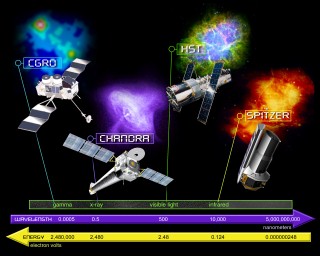NASA’s Great Observatories: Because the Earth's atmosphere prevents certain types of radiation from reaching the ground, NASA proposed a series of Great Observatories designed to conduct space-based astronomical studies over many different wavelengths. The program launched four observatories: the Hubble Space Telescope (visible and near ultraviolet); Compton Gamma Ray Observatory (gamma rays); Chandra X-ray Observatory (soft X-rays); and Spitzer Space Telescope (infrared). Each observatory was designed to push the state of technology in its intended wavelength region.
Credit: NASA/CXC/SAO
The HEAO program was only the beginning. The vision for space research thus far laid the foundation for building a space transportation system and refining the telescope technologies that would result in NASA’s Great Observatories Program. NASA launched the Hubble Space Telescope in 1990, followed by the Compton Gamma Ray Observatory (1991), the Chandra X-Ray Observatory (1999), and the Spitzer Space Telescope (2003), using the space shuttle to carry these observatories into low-Earth orbit where they would open a vast, new window on the amazing Universe.
From time to time I have been asked my opinion on how space research benefits society. It’s hard to put a price tag on this. As time goes on, the science we get in return for every dollar invested rises, in spite of the fact that the costs go up, too, because the information retrieval goes up orders of magnitude with each new mission. If you work on the frontiers of science, you're bound to contribute to society in very beneficial ways, because that's where the new applications and new technologies will come from. Basic research leads the technology, and if we don't have creative science, we won't have productive technology–or innovation (a good word we all use). And you don't get creative science unless you have a flow of fresh young minds into the field.
Science is a field that needs young minds that see things differently and are open to adventure. When you are young, you have the stamina to do rigorous research, to work on a problem that intrigues you for 14 or 16 hours a day! And it’s immensely rewarding, because science allows you to try something new and provides a great sense of adventure that lasts a lifetime. When I was younger I had a general philosophy of looking into any region of the spectrum that had not been explored, and this was part of the adventure for me. I had just the gut feeling that there were surprises everywhere one could look, and it was a mistake to ignore any part of the spectrum. The ultimate excitement of X-ray astronomy in my era was that it really was a new astronomy. We saw things very differently and what we saw related to very exotic processes, like supernova collapse, formation of neutron stars, and black holes. I can't think of more intriguing problems in astronomy. Can you?
The First Black Hole: Since its discovery in 1962, the X-ray binary star Cygnus X-1 has been one of the most intensively studied cosmic X-ray sources. About a decade after its discovery, Cygnus X-1 secured a place in the history of astronomy when a combination of space-based, X-ray observations by the Chandra X-ray Observatory and optical, ground-based observations by the Digitized Sky Survey led to the conclusion that it was a black hole, the first such identification.
Credit: NASA/CXC (X-ray); Digitized Sky Survey (Optical)



